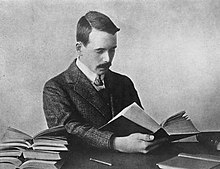
Back هنري موزلي Arabic هنرى موزلى ARZ هنری موزلی AZB Хенри Мозли Bulgarian হেনরি মোসলে Bengali/Bangla Henry Moseley Catalan Henry Moseley Czech Henry Moseley Danish Henry Moseley (Physiker) German Χένρι Μόσλεϊ Greek
Henry Moseley | |
|---|---|
 Moseley in 1914 | |
| Born | Henry Gwyn Jeffreys Moseley 23 November 1887 |
| Died | 10 August 1915 (aged 27) |
| Cause of death | Killed in action |
| Education | Summer Fields School Eton College |
| Alma mater | Trinity College, Oxford University of Manchester |
| Known for | Atomic number, Moseley's law |
| Awards | Matteucci Medal (1919) |
| Scientific career | |
| Fields | Physics, chemistry |
Henry Gwyn Jeffreys Moseley (/ˈmoʊzli/; 23 November 1887 – 10 August 1915) was an English physicist, whose contribution to the science of physics was the justification from physical laws of the previous empirical and chemical concept of the atomic number. This stemmed from his development of Moseley's law in X-ray spectra.
Moseley's law advanced atomic physics, nuclear physics and quantum physics by providing the first experimental evidence in favour of Niels Bohr's theory, aside from the hydrogen atom spectrum which the Bohr theory was designed to reproduce. That theory refined Ernest Rutherford's and Antonius van den Broek's model, which proposed that the atom contains in its nucleus a number of positive nuclear charges that is equal to its (atomic) number in the periodic table.[1][2]
When World War I broke out in Western Europe, Moseley left his research work at the University of Oxford behind to volunteer for the Royal Engineers of the British Army. Moseley was assigned to the force of British Empire soldiers that invaded the region of Gallipoli, Turkey, in April 1915, as a telecommunications officer. Moseley was shot and killed during the Battle of Gallipoli on 10 August 1915, at the age of 27. Experts have speculated that Moseley could otherwise have been awarded the Nobel Prize in Physics in 1916.[3][4]
- ^ Rutherford, E. (1911). "The scattering of α and β particles by matter and the structure of the atom". Philosophical Magazine. 6th series. 21 (125): 669–688.
- ^ Broek, A. van den (1913). "Die Radioelemente, das periodische System und die Konstitution der Atome" [Radio-elements, the periodic system, and the constitution of atoms]. Physikalische Zeitschrift (in German). 14: 32–41.
- ^ Rutherford, Ernest. "Moseley, Henry Gwyn Jeffreys". Oxford Dictionary of National Biography (online ed.). Oxford University Press. doi:10.1093/ref:odnb/35125. (Subscription or UK public library membership required.)
- ^ Asimov, Isaac (1982). "1121. MOSELEY, Henry Gwyn-Jeffreys". Asimov's Biographical Encyclopedia of Science and Technology (2nd revised ed.). New York etc.: Doubleday. pp. 713–714.